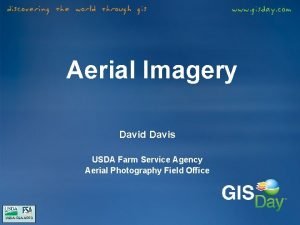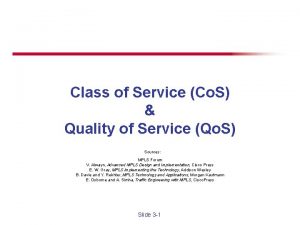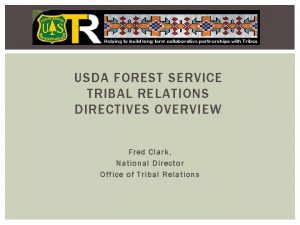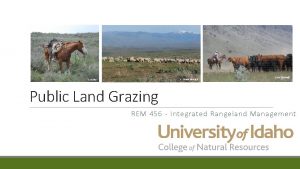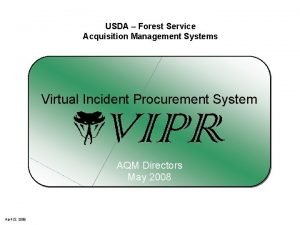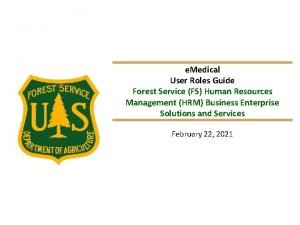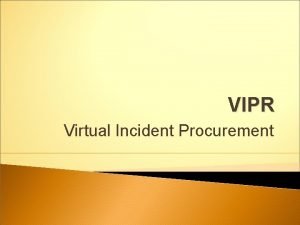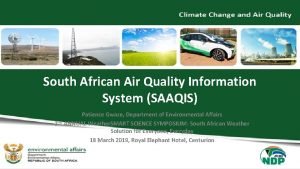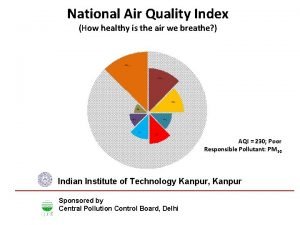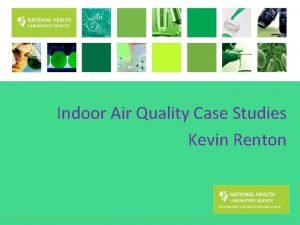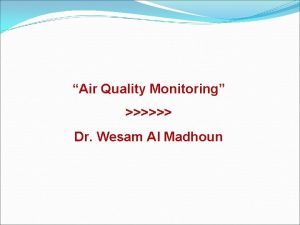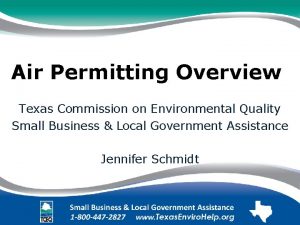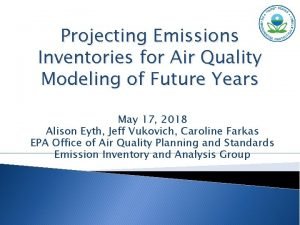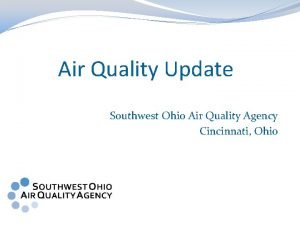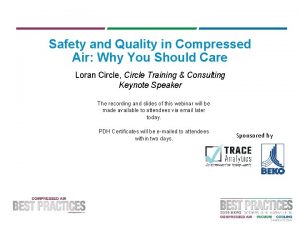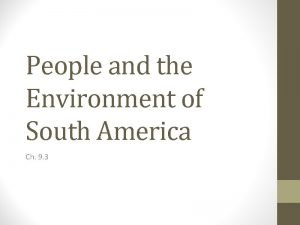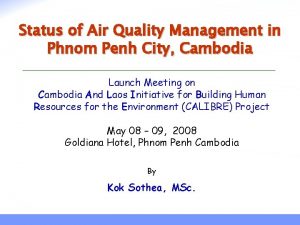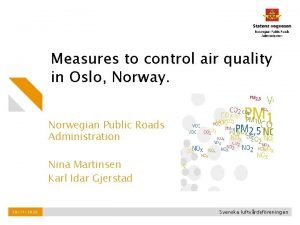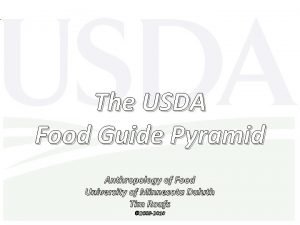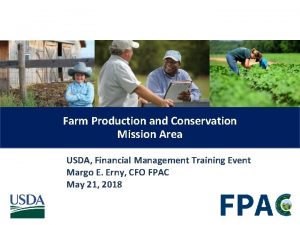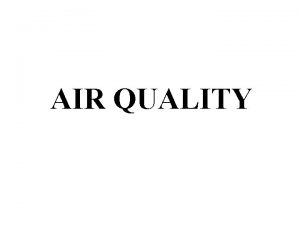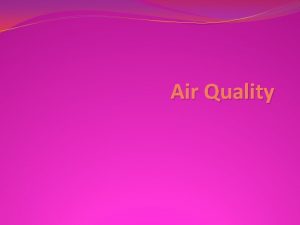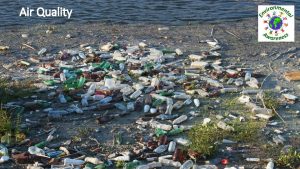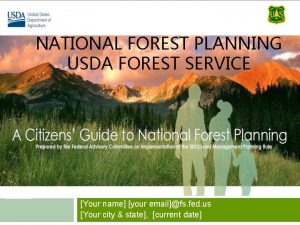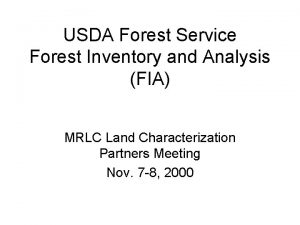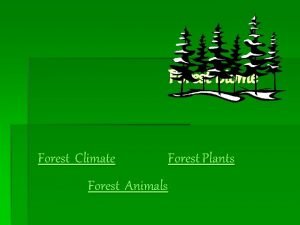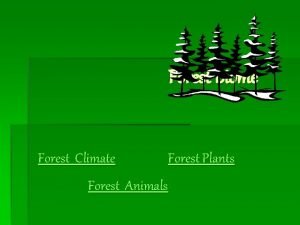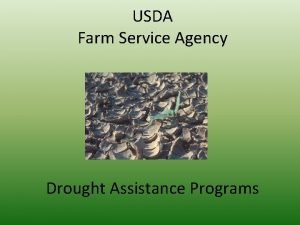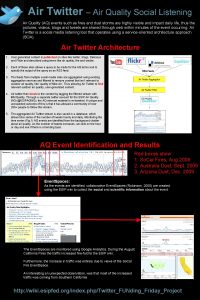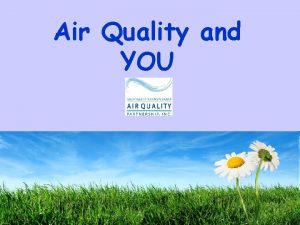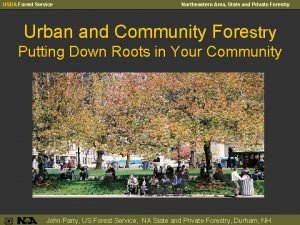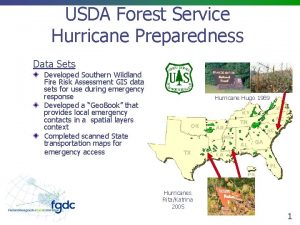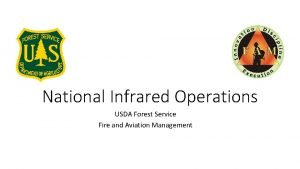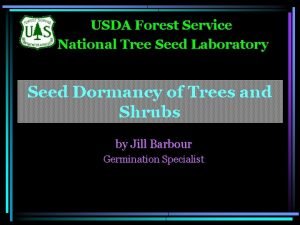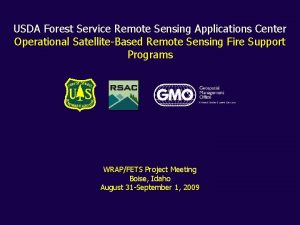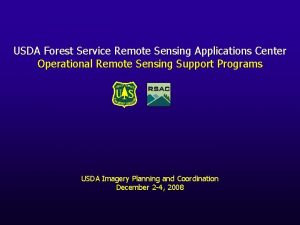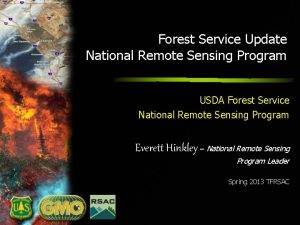Air Quality in the USDA Forest Service A









































- Slides: 41

Air Quality in the USDA Forest Service: A Two Way Street Rich Fisher USDA Forest Service Ft Collins, CO USA 970 -295 -5981 rwfisher@fs. fed. us Cloud Peak Wilderness, Wyoming An area where natural visibility conditions should exist

A Two Way Street: Forest Service Air Resource Management Objectives • Protect the National Forests from the adverse effects of mancaused air pollution • Minimize emissions from management activities and conform with the law

Protecting the National Forests from Man-Caused Air Pollution • Visibility • Deposition to watersheds • Respiration by flora and fauna • Deterioration of cultural artifacts

Visibility • National Goal: Natural visibility in 155 class I areas by 2064 • 86 Class I wildernesses are now impaired by haze • Regional Haze Rule: States must create the first 10 year approvable plan by the end of this year. • Track progress: Interagency aerosol monitoring (IMPROVE)

In the last century, visibility declined 80% in the Eastern U. S. and 20% in the West due to air pollution. Simulating natural and current visibility near the James River Face Wilderness, Virginia using IMPROVE data

Weminuche Wilderness, Colorado Clear Day 90%ile Hazy Day 10%ile Visibility is worsening near energy development areas in NM, CO, WY and UT

• IMPROVE is the national visibility and fine particulate monitoring program with over 163 monitoring sites • 1/3 are US Forest Service sites

Average annual visibility (km) calculated from aerosol concentrations measured in the IMPROVE monitoring program is worst in the East and best in the West.

Sulfates, nitrates, and organic aerosols are key manmade pollutants adversely affecting visibility and other resources on forests nationwide.

Deposition to Watersheds • Decades of high sulfur deposition in the eastern US has acidified many headwater streams. • Excess nitrogen across the US is causing eutrophication and in some places acidification of mountain surface watersheds. • Mercury, common in rainfall across the US, is a hazard to humans who eat Hg bioaccumulators such as fish. • Snowpack accumulation of sulfate or nitrate and subsequent pulses during runoff threaten invertebrates & other forest life and make more costly the purification of drinking water

Snowpack Chemistry Monitoring Nitrate

Snowpack Chemistry Monitoring Ammonium

Respiration by Flora • Ozone is toxic to some individuals of some plant species especially during drought. • Ozone with high nitrogen deposition cause early senescence of leaves together with more vigorous growth resulting in increased leaf litter and a higher fire danger,

Passive Ozone Monitoring Exposure for a week or two. Used together with continuous samplers.

Deterioration of Cultural Artifacts • Ammonia can fertilize undesirable plants and lichens. • Undesirable lichens can destroy petroglyphs Example: Hells Canyon Xanthoria Elegens

11. 00 NH 3 NO 2 NO SO 2 H 2 S Mean ambient concentration (ppb) 10. 00 9. 00 8. 00 7. 00 6. 00 5. 00 4. 00 3. 00 2. 00 1. 00 0. 00 6/25/2003 5/31/2003 5/6/2003 4/11/2003 3/17/2003 2/20/2003 1/26/2003 1/1/2003 12/7/2002 11/12/2002 10/18/2002 9/23/2002 8/29/2002 8/4/2002 7/10/2002 6/15/2002 -1. 00 Exposure midpoint Hells Canyon National Recreation Area Canyon floor ambient air concentrations (ppb) of O 3, SO 2, H 2 S, NOx and NH 3.

Minimize Emissions from Management Activities and Conform with the Law • Smoke from prescribed fire • Emissions from vehicles • Fugitive and road dust • Minerals development

Smoke from Prescribed Fire • Fuel reduction and habitat improvement projects are necessary to restore healthy ecosystems • Wildland fires produce fine particles (PM 2. 5) and ozone precursors • Improved smoke prediction tools • Mobile fine particle monitoring w/ realtime web posting

Criteria Pollutants National Air Quality Standards • Carbon Monoxide • Particulate Matter • Ozone • Nitrogen Oxide • Lead • Sulfur Dioxide Key criteria pollutants generated by fire

Fire Consortia for Advanced Modeling of Meteorology and Smoke www. fs. fed. us/FCAMMS)


Real-time Remote Smoke Monitoring System Data. Ram 4 & ADSI Satellite Modem

PM 10 Bayfield, CO 15 miles Downwind of the Missionary Ridge Fire June 2002

Emissions from Vehicles • • Average urban vehicle emits 30 to 40 milligrams ppvm Average rural vehicle emits 200 to 300 milligrams ppvm • Biodiesel is increasingly being used in gov vehicles • More emphasis needed on: – Hybrid and alternative technology vehicles – Reduced vehicle miles – Remote sensing to gather field data • ORVs (4 -wheelers & snowmobiles, especially 2 -cycle engines) – Surface disturbance promotes fugitive dust – Accumulated sources in poor dispersion areas can cause unhealthy air

Primary Air Quality Standards for Transportation-related Pollutants Pollutant CO Ozone PM 2. 5 PM 10 Averaging Times 8 hour 1 hour Concentration 9 ppm 35 ppm 80 ppb 120 ppb 24 hour Annual 15 ugm/m 3 65 ugm/m 3 50 ugm/m 3 150 ugm/m 3

On-Road Mobile Source Emissions (1993 -2003*)

Percent Contribution in National Inventory of Sources Pollutant Type NOx CO VOC On-Road 35 56 27 Non-Road 19 22 16 Industrial 5 4 46 39 4 6 2 15 5 Fuel Combustion Misc

Non-Road Vehicles Emissions • The entire range of non-road emissions accounted for 49% of engine produced emissions of all types. • Recreational non-road vehicles produced an aggregate of <4% of all HC emissions in the US based – <1. 2 M ATVs used <350 hrs annually on average – EPA emission regulations now include such engines starting with model year 2006. • ATV consumes less than 59 gallons of fuel per year and obtains between 40 and 50 mpg

Fugitive and Road Dust 383, 000 miles of roads on the 192 million acres of national forests in 2000 (most not paved) approx 1 mile of road surface per sq mile of forest Control methods • Surfactants • Speed limits

Emissions Trends 1970 -2002 Miscellaneous: Wildfires Agricultural fires Health services Windblown dust Cooling towers Non Road Engines: Lawn and garden equipment Construction equipment Farm equipment Aircraft Railroads Boats and other marine vessels

PM 10 Emissions 2002

PM 2. 5 Emissions 2002

Minerals Development • Energy independence is a national security issue • Oil & gas is being leased faster than development can occur • Stewardship of air and water requires more careful consideration

Current Ozone Non-Attainment Areas




What are our objectives in the air program ? • Strive for naturally functioning ecosystems unimpaired by human-caused air pollution. • Strive for visibility unimpaired by humancaused air pollution

Will we ever get there ? No… but we can continuously move towards cleaner air by working with others to… • Reduce or eliminate emissions from existing human-caused sources • Ensure that new sources are – cleanest possible – properly sited & operated

And… • Be responsible emitters and land managers – Minimize smoke and it’s impacts – Reduce road dust – Reduce vehicle emissions – Encourage low NOx biofuel use – Encourage carbon sequestration – Encourage conservation

VISION The Air Program envisions a healthy environment for current and future generations where natural processes occur. We believe that: – The health of humans and ecosystems are inseparable – Clean air is essential – Science is the foundation for taking action.
 Pt tanah air sentosa
Pt tanah air sentosa Usda aerial photography
Usda aerial photography Usda food and nutrition service
Usda food and nutrition service Mpls class of service
Mpls class of service Forest service office of tribal relations
Forest service office of tribal relations Us forest service
Us forest service Vipr forest service
Vipr forest service Connect hr emedical
Connect hr emedical Vipr forest service
Vipr forest service Test del escalon del forest service
Test del escalon del forest service Quality assurance vs quality control
Quality assurance vs quality control Pmp quality vs grade
Pmp quality vs grade What are quality standards in project management
What are quality standards in project management Quality assurance cycle in nursing
Quality assurance cycle in nursing Compliance vs quality
Compliance vs quality Basic concept of quality control and quality assurance pdf
Basic concept of quality control and quality assurance pdf Which of the gurus would be the father of quality control?
Which of the gurus would be the father of quality control? Quality is free: the art of making quality certain
Quality is free: the art of making quality certain Old quality vs new quality
Old quality vs new quality Saaqis
Saaqis Air quality index calculation
Air quality index calculation Renton air quality
Renton air quality Ambient air quality standards
Ambient air quality standards St louis air quality
St louis air quality Tceq de minimis
Tceq de minimis Air quality
Air quality Sw ohio air quality
Sw ohio air quality Air quality
Air quality Sao paulo air quality
Sao paulo air quality Phnom penh
Phnom penh Oslo air quality
Oslo air quality Tulare air quality
Tulare air quality Aglearn usda
Aglearn usda Paycheck8 usda
Paycheck8 usda ආහාර පිරමීඩය
ආහාර පිරමීඩය Single family housing guaranteed loan program
Single family housing guaranteed loan program Googla chrome
Googla chrome Food buying guide cacfp
Food buying guide cacfp What is fpac
What is fpac Eforms usda
Eforms usda Usda civil rights training
Usda civil rights training Usda food pyramid 1970
Usda food pyramid 1970

